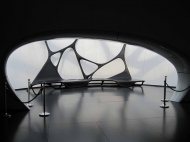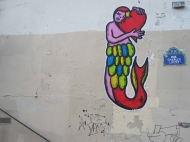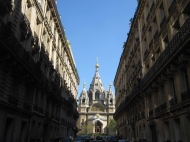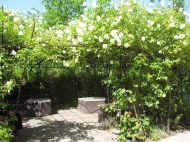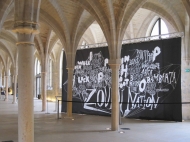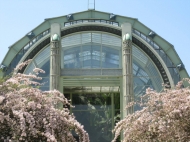Seen from Paris, blog about Paris
You thought Parisians are witty, arrogant, bitching about everything and anything, obsessed with food and culture, and always up for discussion? Well... you're perfectly right! And you're on the right page to check it out.
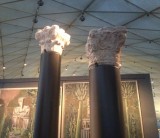
The Islamic Art department of the Louvre reopens in a cutting-edge architecture.
The world’s largest museum was missing part of its collection in the last years: 1500 years of exquisite islamic art was held concealed in the vault while millions were spent for a new presentation.
The Islamic Art collection of the Louvre contains almost 20 000 pieces, and makes it one of the richest and most complete collection in the world. As usual. Because that’s true for almost any department of the Louvre. Yet, given the importance of Islam in our modern world, and of Muslim tourism in Paris, it became important to modernize the presentation of these jewels.
The result is stunning: The collection is presented on 2 levels, one of them being totally new. And that’s the new thing about it. As they did to present French 17th century outside sculptures (you know, the little marble stuff you use to put in your backyard in those days), the Louvre decided again to cover one of the palace’s courtyards. Except this time, they wanted something radically contemporary.
Two architects, Rudy Ricciotti and Mario Bellini, created then a rather outstanding glass roof. A shapeless structure that seems to be floating to the wind, supported by pillars with a random angle, and giving a particular dimmed light through a thin iron net. In case of a sunny day, the result is impressive: you really have the impression to walk under a magical tent in the Sahara desert… And this structure still allows you to see the traditional French ornaments of the original courtyard, creating a « Dialogue » between the two architectures, and we know dialogue is the overall paradigm of museography these days…
Then the collection itself. Well the Louvre, in all of their writings, including their permanent website, seems to apologize about it, claiming in all kinds of possible ways that although the collection covers 1500 years, it is a very homogenous collection. If you read through the lines, they warn you: you might find it boring. They even give, at the beginning, a bit of explanation, like for instance there is no difference between religious and non-religious items in term of ornament. And it’s true, as they chose a chronological way to display the pieces, you seem to constantly be seeing the same thing, mostly ceramic pieces. Up to the moment when you think you cannot take more of them…
Is really Islamic Art that boring? I didn’t count them, but I’m sure there is over 2000 pieces of broken plates. It really makes me wonder if somewhere, somebody gets really excited about broken plates, or if they just felt that they had to show them. The problem when you display so many little -and, must I write it?- pointless artifacts, is that it tends to cannibalize the interest for more interesting pieces. Because there are a lot of beautiful interesting pieces, from marble tombstones to bronze fountain ornaments. Yet, at one point, you don’t see them anymore, lost between another carafe and 150 pieces of tiles. Even the carpets end up looking dull, and the wonderful Persian miniatures arrive a bit late, as you really feel you’d like to go to another department…
What happens is probably, again, the stranglehold of experts on the art. And when I say experts, I would not be surprised that we find some people that are not at all experts, but have a complementary decisional position in the public culture system and a very very big head. The whole path of presentation smells very much like infatuation and ego, and turns the audience away from a better knowledge of these arts, and its appreciation. Because we know it: all of these pieces were made to impress and to make people dream, and they should still be doing it today. But they failed. It’s dull and boring, and overwhelming. And you feel it in the explanations.
In French museums today, it is not possible to write a simple sentence, you have to use as many complex periphrases with forgotten words as you can. It’s rather pathetic, and of course it gets on the way of understanding. Another sign of pretentious presentation is the use of « new » names when it comes to foreign people and concepts, in order to make it look like the team writing is at a higher level of knowledge than you. For instance, you do not write « Mahomet » or « Ommeyades » anymore, but « Muhammad » and « Umayades ». And nobody cares if that’s not the right French words, or if they come out of nowhere, because they appear closer to the civilization concerned. We are kind of lucky that they did not write all the names directly in Arabic characters…
So as you are lost in all this, finding a piece you are looking for is a total ordeal, as everything looks alike and nobody is really there to let you know where things are located. One of the most interesting piece is le Baptistère de Saint-Louis (Saint-Louis’s Baptistry). This is a very interesting piece, both for its beauty, and for its history. One of these pieces that makes the Louvre such a magical museum. This highly ornate metal bowl is not only stunning for the details of the images on it, but also because it was used to baptized all the French kings since 1601. The coat of arm with the Fleur-de-Lys, symbol of the French monarchy, creates a very interesting contrast with the scenes of the Sultan’s tournament. And one can love the idea that one of the most sacred object, where princes became Christians, and representatives of God in France, was in fact a Muslim 13th century piece. Except that you need at least 20 minutes to find that piece, in one corner of the room.
That’s too bad; pieces like this should be set in an environment that would enhance their sacred position, and make us dream as it did impress the high nobility back in the 18th century. But now we feel like walking in some Auction house exhibition, and it takes the magic away.
So yes, do visit the Islamic Arts department of the Louvre, for its shady glass tent and some of its masterpieces. But, unless you love pieces of glass and repetition of copper jars, do not expect to stay too long inside, and focus to the pieces that draw your attention, instead of aiming at following the whole path. You will then get a greater pleasure from your visit…
